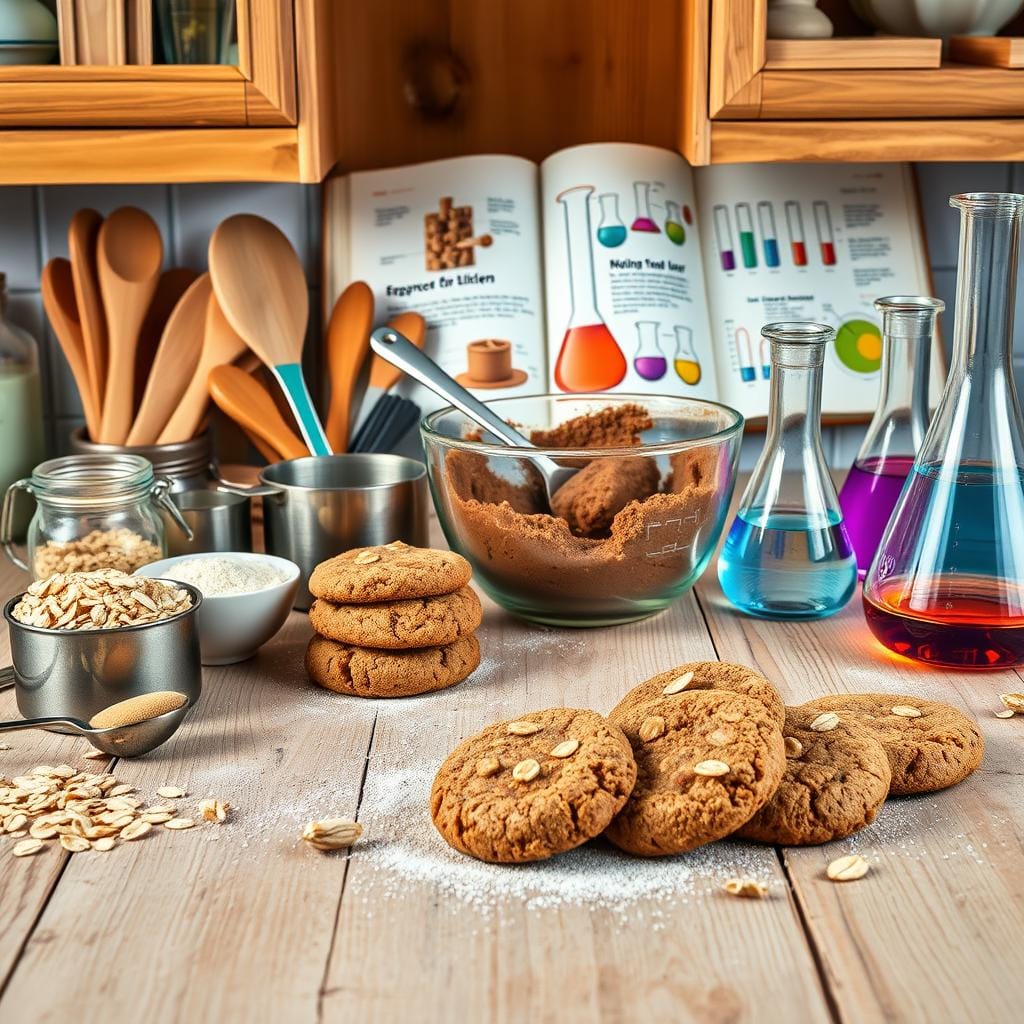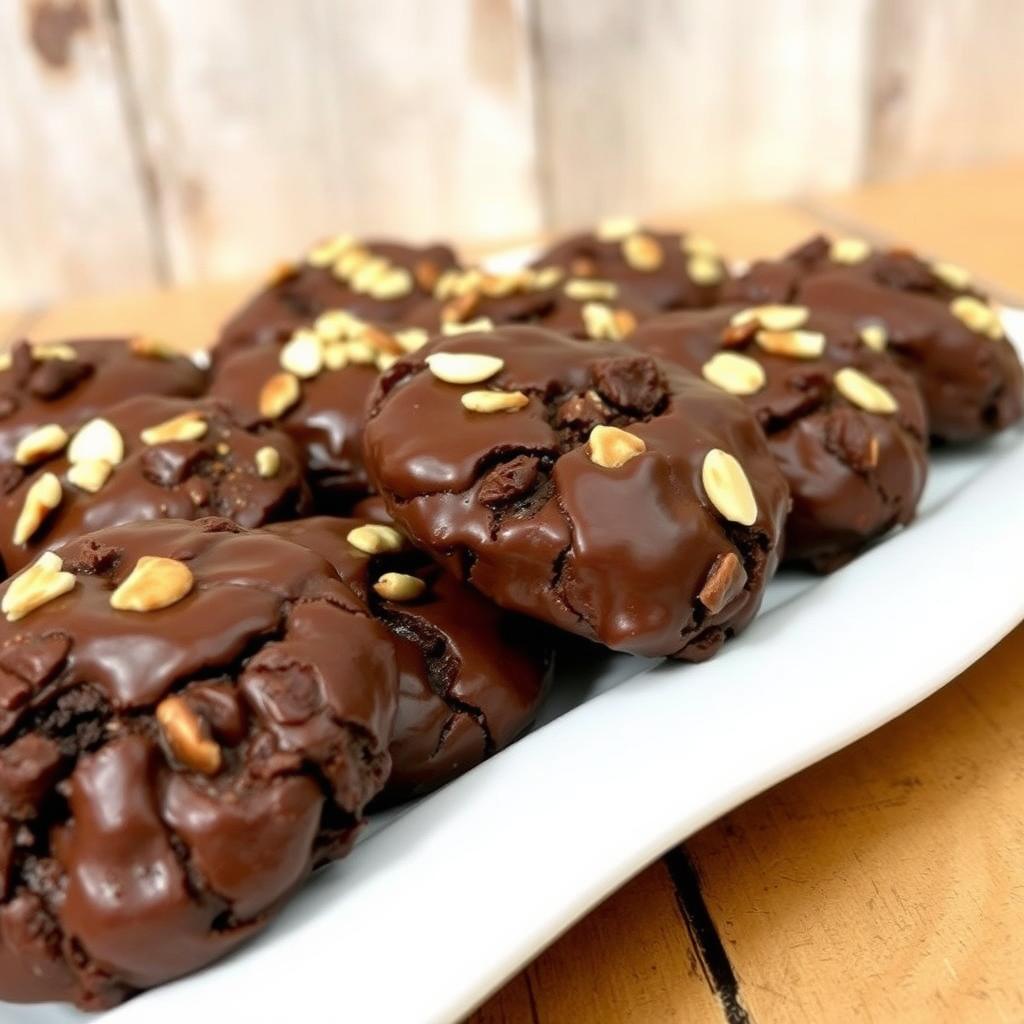As a home baker, it’s frustrating when no-bake cookies don’t turn out right. They should be firm and delicious, but often they’re soft and crumbly. This problem can make you feel like you’ve failed, wondering what went wrong and how to fix it.
But don’t worry, you’re not alone. There are ways to make your no-bake cookies firm and tasty. We’ll explore the reasons behind this issue and offer solutions to help you succeed.

Key Takeaways
- Understand the science behind no-bake cookie consistency to troubleshoot issues
- Identify and correct common ingredient mistakes that affect cookie texture
- Optimize boiling time, cooling techniques, and storage methods for perfectly hard no-bake cookies
- Adjust recipes for different climates and altitudes to ensure consistent results
- Utilize the right equipment and tools to achieve the desired texture
In this article, we’ll look at why your no-bake cookies might not be firm. We’ll share practical tips to help your future batches turn out perfectly. Whether you’re new to no-bake recipes or an experienced baker, you’ll find useful advice here. Say goodbye to soft cookies and hello to delicious, firm no-bake treats.
Understanding the Science Behind No-Bake Cookie Consistency
Making the perfect no-bake cookie is more than just a recipe. It’s about understanding the baking science that makes them special. This includes sugar crystallization, temperature, and moisture balance. These basics help achieve the right cookie texture.
The Role of Sugar Crystallization
No-bake cookies get their firm yet chewy feel from sugar crystallization. When the sugar mixture cools, it forms crystals. This process is key to the cookie’s texture. It’s important to control the boiling and cooling times for the best results.
Temperature’s Impact on Setting
The temperature of no-bake cookies is very important. If it’s too hot, the cookies can dry out. If it’s too cold, they won’t set right. Getting the temperature just right is crucial for the perfect cookie.
Moisture Balance Fundamentals
Getting the moisture right in no-bake cookies is tricky. Too much makes them soft, too little makes them dry. Knowing how ingredients, cooking time, and cooling affect moisture is essential for the right cookie texture.
By understanding the science behind no-bake cookies, bakers can make perfect treats every time. Knowing about sugar, temperature, and moisture makes the process rewarding and tasty.

“Mastering the science of no-bake cookie consistency is the key to unlocking a world of culinary delight.”
Why Won’t My No-Bake Cookies Get Hard?
Having trouble making your no-bake cookies hard? You’re not alone. Many people struggle with this, feeling frustrated and unsure if they’re good at cooking. But, there are simple fixes for soft no-bake cookies.
The right mix of ingredients is key. The sugar and liquid ratio affects how hard the cookies get. Too much liquid makes them soft, while too little makes them crumbly.
Temperature also matters a lot. No-bake cookies harden through sugar crystallization, which needs high heat. If the mix isn’t hot enough, the cookies won’t set right.
Finally, humidity can mess with your cookies. High air moisture stops them from drying and hardening. This means your cookies might stay sticky and soft.
Don’t give up! Understanding the science behind no-bake cookies and trying a few fixes can help. Check out our Legendary Recipes for tips to make your cookies perfect every time.

Common Ingredient Mistakes Affecting Cookie Texture
Making the perfect no-bake cookies can be tricky. Small mistakes with ingredients can stop your cookies from being hard and fudgy. Let’s look at the most common mistakes and how to fix them.
Incorrect Sugar-to-Liquid Ratio
The right mix of sugar and liquid, like milk or peanut butter, is key. If it’s wrong, your cookies might be too soft or crumbly. Make sure to measure everything carefully and stick to the recipe for the best texture.
Wrong Type of Butter Used
The butter you use can change your cookies’ texture a lot. Always choose unsalted butter to avoid too much salt. Also, don’t use margarine or other butter substitutes because they can’t harden properly.
Oat Measurement Problems
Oats are important in no-bake cookies, but measuring them right is crucial. Too few oats make cookies soft and gooey, while too many make them dry. Always measure oats as the recipe says and adjust if needed for the right texture.
Knowing these common mistakes helps you fix your no-bake cookie recipes. Focus on the ingredient proportions to avoid cooking mishaps and make tasty no-bake recipes.
The Perfect Boiling Time for No-Bake Cookies
Getting the right consistency in no-bake cookies is all about the boiling time. The time you boil sugar, butter, and milk is key. It affects the final texture of your treats.
Boiling them too little makes them soft and gooey. Boiling them too long makes them hard and crumbly. Finding the right boiling time is crucial for cooking time. It helps solve troubleshooting baking and culinary challenges.
Boiling Time Guidelines
- For a standard no-bake cookie recipe, boil for 2 to 3 minutes.
- But, this can change based on sugar type, saucepan size, and altitude.
- Use a timer and watch the mixture closely. It should boil fully before starting the timer.
- When the timer goes off, take the saucepan off the heat and follow the recipe.
Getting the perfect cooking time for no-bake cookies takes practice. But with some troubleshooting baking and attention, you can get it right every time.
| Boiling Time | Cookie Texture |
|---|---|
| Less than 2 minutes | Soft and gooey |
| 2-3 minutes | Perfectly set and firm |
| More than 3 minutes | Hard and crumbly |
“The key to perfect no-bake cookies is all in the boiling time. Nail it, and you’ll have a batch of delicious, fudgy treats every time.”
Weather and Humidity Effects on Cookie Setting
Baking is a delicate science, and no-bake cookies are no exception. One common issue is soft, fudgy cookies that won’t set right. Weather and humidity in your kitchen are often the culprits. Knowing how these factors affect cookie texture is crucial for perfect results, even with kitchen mishaps.
High Humidity Solutions
High humidity can mess up your no-bake cookie texture. The extra moisture in the air stops the cookies from drying and hardening. To fix this:
- Use less liquid in your recipe, like milk or cream, to counteract the air’s moisture.
- Try chilling or freezing the cookies after shaping to help them set faster.
- Adding a desiccant, like silica gel packets, to your storage can help absorb extra humidity.
Seasonal Adjustments
Humidity changes a lot with the seasons. Watch how your no-bake cookies do in different weather and adjust your recipe as needed:
- In summer, when it’s humid, use less liquid and chill the cookies after shaping.
- In winter, when it’s drier, you might need to add a bit more liquid to keep the cookies from drying out too fast.
- Keep an eye on your cookies and make small changes to get the perfect cookie texture every time.
Understanding how weather and humidity affect your no-bake cookies can help you overcome any kitchen mishaps. This way, you can always make delicious, well-set treats.
Storage Methods That Impact Cookie Hardness
Keeping your no-bake cookies just right is key to enjoying them. But, if you store them wrong, they can turn out bad. We’ll look at how to store them to keep them crunchy.
Airtight Containers for Crunch
Putting your cookies in an airtight container keeps them crunchy. It stops moisture from making them soft. Use a container with a tight lid, like plastic or glass, to keep air out.
Refrigeration for Longer Shelf Life
Storing cookies in the fridge can make them last longer and stay crunchy. The cold slows down sugar changes, which helps keep them hard. Just watch out for moisture that can make them soft, and keep them in a sealed container.
Avoiding Freezing for Texture Preservation
Freezing is not the best way to store no-bake cookies. The cold can mess with the ingredients, making them crumbly. If you freeze them, use a container that keeps moisture out and thaw them slowly.
Knowing how to store your no-bake cookies can make them always taste great. Use airtight containers, the fridge, and avoid freezing. This way, you’ll always have delicious cookies ready to go.
Essential Equipment for Perfect No-Bake Cookies
Making no-bake cookies is an art that needs the right tools. Whether you’re experienced or new, the right equipment makes a big difference. It helps get the perfect texture and consistency. Let’s explore the key tools for baking science, culinary challenges, and avoiding kitchen mishaps.
Choosing the Right Cookware
The right cookware is crucial for perfect no-bake cookies. Choose a heavy-bottomed saucepan or Dutch oven for even heating. This prevents hot spots that can ruin the texture.
Stainless steel or enameled cast iron pans are great. They heat well and are easy to clean.
Temperature Measurement Tools
- Digital Thermometer: Get a reliable digital thermometer for your no-bake cookie mix. It’s key for the right consistency and avoiding cooking mistakes.
- Candy Thermometer: A candy thermometer is essential. It helps track the sugar syrup’s temperature to the perfect setting point.
- Oven Thermometer: An oven thermometer ensures your oven is at the right temperature. This is important for baking the cookies, if needed.
With the right tools and understanding of no-bake cookie science, you’ll make delicious treats. These will impress your family and friends.
Quick Fixes for Soft No-Bake Cookies
If your no-bake cookies are still soft, don’t worry. There are quick fixes to make them perfect. Troubleshooting baking mishaps can be challenging, but you can fix them. With the right methods, you can turn them into crunchy treats.
One easy fix is to put the cookies back in the fridge or freezer for 30 minutes to an hour. The cold will help solidify the fats and sugars. If they’re still soft, add more oats or nuts. This can soak up extra moisture and make them firmer.
Another trick is to warm the cookie dough slightly on the stovetop or in the microwave. This re-melts the fats and sugars, letting them set again as they cool. But be careful not to overheat, as it can make them too soft.
If you’re still having trouble, try sprinkling powdered sugar or cocoa powder on top. These can help dry out the cookies and make them crisper.
With a bit of trial and error, you can make your soft no-bake cookies crisp and delicious. Remember, it’s all about understanding the ingredients and adjusting your method. Happy baking!
Proper Cooling Techniques and Environment
Getting the right cookie texture for no-bake recipes is more than just ingredients and cooking. Cooling techniques and the environment are key to setting and hardening your cookies.
Optimal Surface Selection
The surface you cool your no-bake cookies on affects their texture. Choose a clean, flat surface like a baking sheet or countertop with parchment paper. Stay away from wet or uneven surfaces to ensure proper no-bake recipe hardening.
Air Circulation Considerations
For no-bake cookies to set right, air circulation is essential. Place the cooling cookies where air flows well, like in front of a fan or near an open window. Without good airflow, cookies might not harden evenly and could end up sticky or gooey.
| Cooling Technique | Ideal Temperature | Humidity Level | Airflow |
|---|---|---|---|
| Baking Sheet | 65-75°F | 40-50% | Moderate |
| Countertop | 70-80°F | 30-45% | Good |
| Refrigerator | 40-45°F | 60-70% | Low |
Focus on your cooling surface and air flow to achieve the perfect cookie texture in your no-bake recipes.
Recipe Modifications for Different Altitudes
Baking no-bake cookies can be fun, but altitude matters. Knowing how to adjust ingredient proportions and solve culinary challenges is key. It helps to troubleshoot recipes for different heights.
At higher altitudes, the air pressure changes. This can make your ingredients act differently. Here are some tips to get your cookies right, no matter where you are.
Adjusting Ingredient Quantities
- Lower the sugar by 1-2 tablespoons per cup. This prevents sugar from becoming too hard at high altitudes.
- Add 1-2 tablespoons more milk or cream. This helps keep the cookies moist at high altitudes.
- Use a bit more butter or oil. This keeps the cookies from drying out.
Modifying Cooking Times
At high altitudes, water boils at a lower temperature. This changes how long you need to cook your cookies. Reduce the cooking time by 1-2 minutes. Watch the mixture closely to avoid it becoming too hard.
| Altitude | Boiling Time Adjustment |
|---|---|
| 1,000 feet | Reduce by 1 minute |
| 3,000 feet | Reduce by 2 minutes |
| 5,000 feet | Reduce by 3 minutes |
These are just starting points. You might need to tweak things to get it just right. With a bit of troubleshooting and care, you can make perfect no-bake cookies at any altitude.
Conclusion
Learning to make no-bake cookies that harden perfectly is a mix of science and skill. You now know how sugar crystallization and temperature play a part. You also understand how to fix common mistakes that make cookies soft and gooey.
To get the right texture, try adjusting your boiling time or using the right equipment. Weather and humidity can also affect your cookies. The tips in this article will help you make no-bake cookies that are crunchy every time.
Remember, every recipe and kitchen is different. Don’t be afraid to try new things and find what works for you. With these tips, you can make no-bake recipes that turn out just right. Say goodbye to cooking mishaps and enjoy your why won’t my no-bake cookies get hard? treats.

